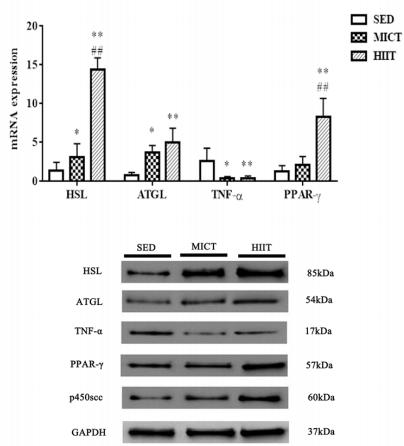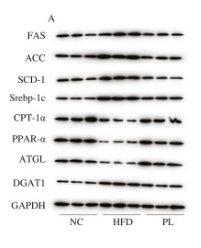PNPLA2 Antibody - #DF7756
| Product: | PNPLA2 Antibody |
| Catalog: | DF7756 |
| Description: | Rabbit polyclonal antibody to PNPLA2 |
| Application: | WB IHC IF/ICC |
| Cited expt.: | WB |
| Reactivity: | Human, Mouse |
| Mol.Wt.: | 54 kDa; 55kD(Calculated). |
| Uniprot: | Q96AD5 |
| RRID: | AB_2841222 |
Related Downloads
Protocols
Product Info
*The optimal dilutions should be determined by the end user. For optimal experimental results, antibody reuse is not recommended.
*Tips:
WB: For western blot detection of denatured protein samples. IHC: For immunohistochemical detection of paraffin sections (IHC-p) or frozen sections (IHC-f) of tissue samples. IF/ICC: For immunofluorescence detection of cell samples. ELISA(peptide): For ELISA detection of antigenic peptide.
Cite Format: Affinity Biosciences Cat# DF7756, RRID:AB_2841222.
Fold/Unfold
1110001C14Rik; Adipose triglyceride lipase; ATGL; ATGL DESNUTRIN; Calcium independent phospholipase A2; Calcium-independent phospholipase A2; Desnutrin; EC 3.1.1.3; FP17548; IPLA2 zeta; IPLA2-zeta; Mutant patatin like phospholipase domain containing 2; Patatin like phospholipase domain containing 2; PATATIN LIKE PHOSPHOLIPASE DOMAIN CONTAINING PROTEIN 2; Patatin-like phospholipase domain-containing protein 2; PEDF R; PHOSPHOLIPASE A2 CALCIUM INDEPENDENT ZETA; Pigment epithelium derived factor; Pigment epithelium-derived factor; plpl; plpl2; PLPL2_HUMAN; Pnpla2; Transport secretion protein 2; Transport secretion protein 2.2; Transport-secretion protein 2; Triglyceride hydrolase; TTS 2.2; TTS2; TTS2.2; ZETA;
Immunogens
A synthesized peptide derived from human PNPLA2, corresponding to a region within the internal amino acids.
Highest expression in adipose tissue. Also detected in heart, skeletal muscle, and portions of the gastrointestinal tract. Detected in normal retina and retinoblastoma cells. Detected in retinal pigment epithelium and, at lower intensity, in the inner segments of photoreceptors and in the ganglion cell layer of the neural retina (at protein level).
- Q96AD5 PLPL2_HUMAN:
- Protein BLAST With
- NCBI/
- ExPASy/
- Uniprot
MFPREKTWNISFAGCGFLGVYYVGVASCLREHAPFLVANATHIYGASAGALTATALVTGVCLGEAGAKFIEVSKEARKRFLGPLHPSFNLVKIIRSFLLKVLPADSHEHASGRLGISLTRVSDGENVIISHFNSKDELIQANVCSGFIPVYCGLIPPSLQGVRYVDGGISDNLPLYELKNTITVSPFSGESDICPQDSSTNIHELRVTNTSIQFNLRNLYRLSKALFPPEPLVLREMCKQGYRDGLRFLQRNGLLNRPNPLLALPPARPHGPEDKDQAVESAQAEDYSQLPGEDHILEHLPARLNEALLEACVEPTDLLTTLSNMLPVRLATAMMVPYTLPLESALSFTIRLLEWLPDVPEDIRWMKEQTGSICQYLVMRAKRKLGRHLPSRLPEQVELRRVQSLPSVPLSCAAYREALPGWMRNNLSLGDALAKWEECQRQLLLGLFCTNVAFPPEALRMRAPADPAPAPADPASPQHQLAGPAPLLSTPAPEARPVIGALGL
Research Backgrounds
Catalyzes the initial step in triglyceride hydrolysis in adipocyte and non-adipocyte lipid droplets. Also has acylglycerol transacylase activity. May act coordinately with LIPE/HLS within the lipolytic cascade. Regulates adiposome size and may be involved in the degradation of adiposomes. May play an important role in energy homeostasis. May play a role in the response of the organism to starvation, enhancing hydrolysis of triglycerides and providing free fatty acids to other tissues to be oxidized in situations of energy depletion.
Phosphorylation at Ser-404 by PKA is increased during fasting and moderate intensity exercise, and moderately increases lipolytic activity (By similarity). Phosphorylation at Ser-404 is increased upon beta-adrenergic stimulation.
Lipid droplet. Cell membrane>Single-pass type II membrane protein.
Highest expression in adipose tissue. Also detected in heart, skeletal muscle, and portions of the gastrointestinal tract. Detected in normal retina and retinoblastoma cells. Detected in retinal pigment epithelium and, at lower intensity, in the inner segments of photoreceptors and in the ganglion cell layer of the neural retina (at protein level).
Research Fields
· Metabolism > Lipid metabolism > Glycerolipid metabolism.
· Metabolism > Global and overview maps > Metabolic pathways.
· Organismal Systems > Endocrine system > Regulation of lipolysis in adipocytes.
References
Application: WB Species: Mouse Sample:
Application: WB Species: Mouse Sample:
Application: WB Species: Mouse Sample:
Application: WB Species: rat Sample: fat
Restrictive clause
Affinity Biosciences tests all products strictly. Citations are provided as a resource for additional applications that have not been validated by Affinity Biosciences. Please choose the appropriate format for each application and consult Materials and Methods sections for additional details about the use of any product in these publications.
For Research Use Only.
Not for use in diagnostic or therapeutic procedures. Not for resale. Not for distribution without written consent. Affinity Biosciences will not be held responsible for patent infringement or other violations that may occur with the use of our products. Affinity Biosciences, Affinity Biosciences Logo and all other trademarks are the property of Affinity Biosciences LTD.







